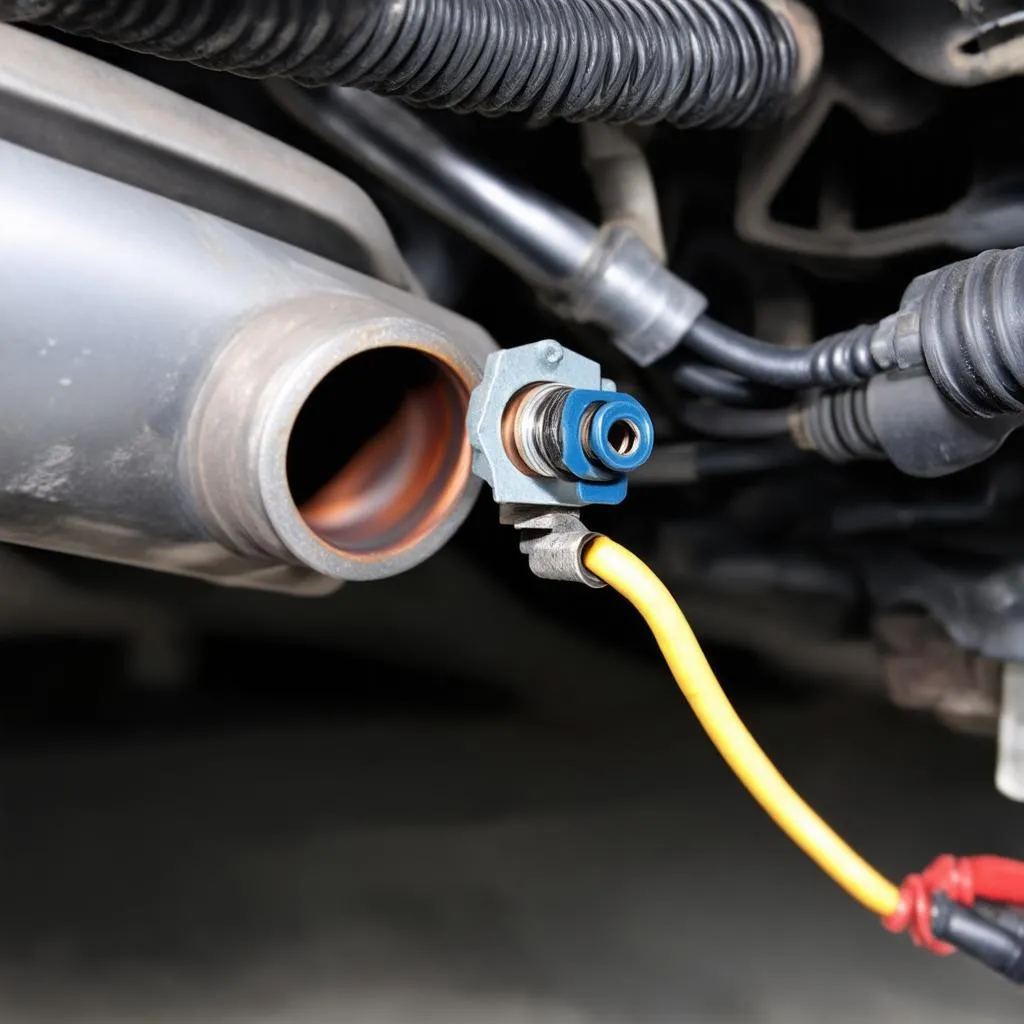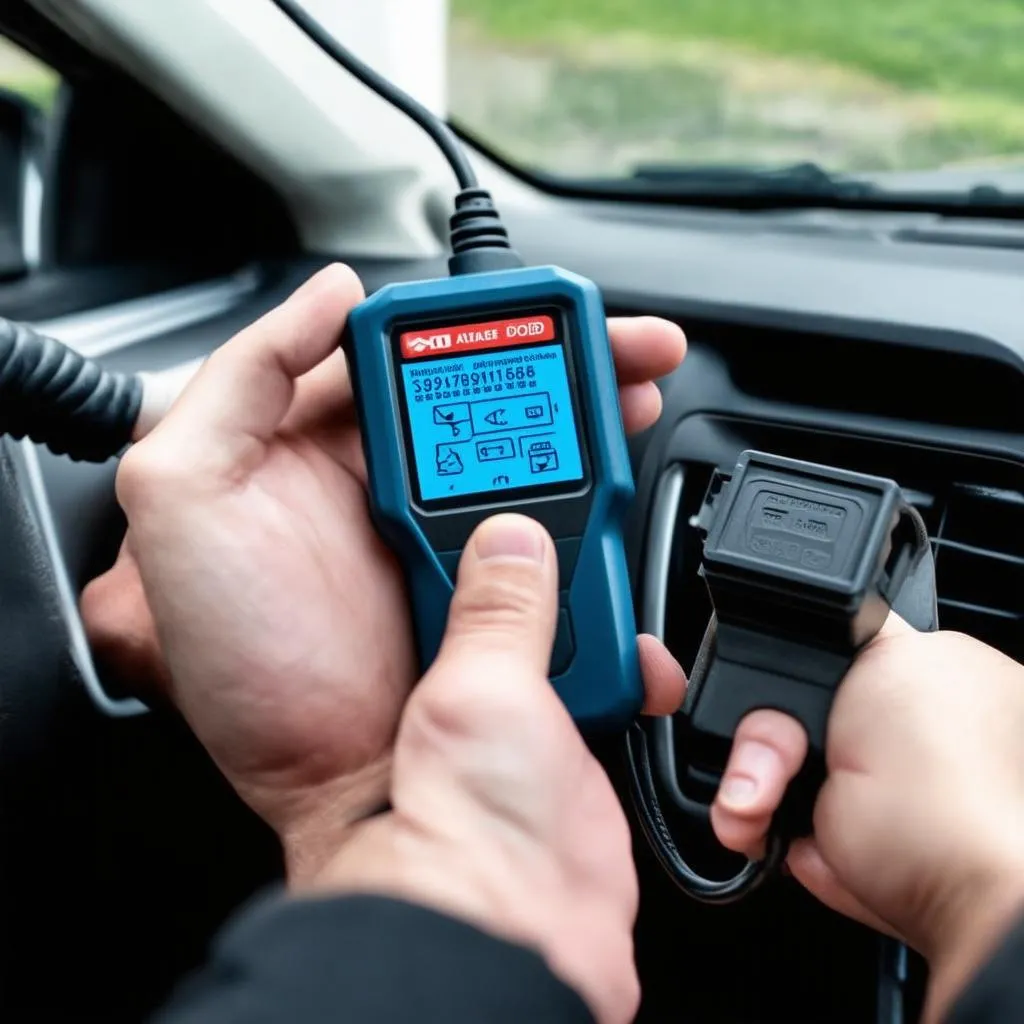Have you ever been cruising down the highway, enjoying the open road, when suddenly your car starts acting up? A flashing light on your dashboard, a strange noise under the hood, or a loss of power can be a real buzzkill. And for Chevrolet Aveo owners, seeing the code “P0131” pop up on their OBD reader can be particularly concerning. It might feel like a cryptic message from your car, leaving you wondering what it means and how to fix it. But don’t worry, we’re here to decipher this code and guide you through the process of getting your Aveo back on the road.
What Does the P0131 Code Mean?
The P0131 code is a diagnostic trouble code (DTC) that indicates a malfunction in the oxygen sensor (O2 sensor) located before the catalytic converter on the first bank of cylinders. This sensor plays a crucial role in your car’s emissions control system by measuring the amount of oxygen in your exhaust gases. This information is then sent to the engine control module (ECM) to adjust the air-fuel mixture for optimal performance and emissions reduction.
Imagine your car’s engine as a chef trying to cook the perfect dish. The O2 sensor is like the chef’s taste buds, informing the chef whether the dish needs more seasoning (fuel) or less (air). If the O2 sensor is malfunctioning, the ECM can’t get accurate feedback, resulting in a poor air-fuel mixture, leading to decreased fuel efficiency, increased emissions, and potentially even engine damage.
P0131 Code: The Common Causes
Several issues can trigger the P0131 code, and it’s important to understand the underlying reasons to troubleshoot and repair your Chevrolet Aveo effectively. Let’s dive deeper into these causes and explore the possible solutions:
1. Faulty O2 Sensor
This is the most common culprit behind the P0131 code. The O2 sensor is a delicate component exposed to high temperatures and harsh conditions. Over time, it can wear down, get contaminated, or simply fail.
Solution: Replace the faulty O2 sensor with a new, compatible one. It’s recommended to purchase a high-quality sensor from a reputable manufacturer to ensure proper functionality and longevity.
2. Wiring Issues
The O2 sensor is connected to the ECM by wiring, and any damage or corrosion in this wiring can disrupt the signal transmission, triggering the P0131 code.
Solution: Inspect the wiring connecting the O2 sensor to the ECM. Look for any breaks, chafing, or corrosion. If you find any issues, repair or replace the damaged wiring to restore proper communication between the sensor and the ECM.
3. Catalytic Converter Problems
A clogged or damaged catalytic converter can hinder exhaust flow, causing the O2 sensor to send inaccurate readings.
Solution: If the catalytic converter is suspect, it might need to be replaced. However, it’s crucial to inspect and diagnose the issue properly before replacing the converter, as other factors might be responsible for the problem.
4. Vacuum Leaks
Leaks in the engine’s vacuum system can disrupt the air-fuel mixture, affecting the O2 sensor’s readings.
Solution: Carefully inspect the engine’s vacuum lines for cracks, leaks, or loose connections. Repair or replace any faulty vacuum lines to ensure proper engine operation and accurate O2 sensor readings.
5. Fuel System Problems
Issues in the fuel system, such as a faulty fuel injector or a clogged fuel filter, can affect the fuel-air mixture, potentially causing the O2 sensor to malfunction.
Solution: Check the fuel system for any problems, including fuel injector performance, fuel pressure, and fuel filter condition. Address any issues found to ensure the fuel system operates correctly and provides the right fuel-air mixture to the engine.
What to Do When You See the P0131 Code
- Don’t panic! Seeing a code on your dashboard can be alarming, but it’s important to stay calm and approach the situation systematically.
- Use an OBD scanner: Connect an OBD scanner to your Aveo’s diagnostic port and retrieve the P0131 code. This will provide you with more specific information about the issue.
- Review the code: Once you have the code, you can research its meaning and common causes. Websites like techcarusa.com can be a great resource for understanding codes and finding solutions.
- Inspect the O2 sensor: Visually inspect the O2 sensor for any signs of damage, corrosion, or debris.
- Check the wiring: Examine the wiring connecting the O2 sensor to the ECM. Look for any breaks, chafing, or corrosion.
- Consider other potential causes: If the O2 sensor and wiring seem fine, consider other possible issues like vacuum leaks or fuel system problems.
- Professional assistance: If you’re not comfortable diagnosing or repairing the problem yourself, take your Aveo to a qualified mechanic for professional diagnosis and repair.
Important Note: It’s crucial to use a high-quality O2 sensor specifically designed for your Chevrolet Aveo. Using an incompatible sensor can lead to further problems or damage to your car.
Frequently Asked Questions About the P0131 Code
Is the P0131 code serious?
The P0131 code can indicate a potential issue that should be addressed promptly. A malfunctioning O2 sensor can affect fuel efficiency, increase emissions, and even lead to engine damage in severe cases.
Can I drive with the P0131 code?
You might be able to drive with the P0131 code for a short time, but it’s generally not advisable. Driving with a faulty O2 sensor can lead to decreased fuel efficiency, increased emissions, and potential engine problems.
What if I keep getting the P0131 code after replacing the O2 sensor?
If the P0131 code persists even after replacing the O2 sensor, it indicates that the issue might be related to other components in the emissions control system, such as wiring, the catalytic converter, or vacuum leaks.
Can I clear the P0131 code myself?
You can clear the P0131 code using an OBD scanner, but it’s essential to address the underlying issue causing the code. Clearing the code without fixing the problem will only make it reappear.
Additional Information about the P0131 Code
The P0131 code is a universal code meaning it can appear on many different car models, not just Chevrolet Aveos. However, the specific causes and solutions may vary depending on the make and model of your vehicle.
You can also check the manufacturer’s service manual for your specific car for more detailed information on diagnosing and repairing the P0131 code.
Conclusion
The P0131 code can be a frustrating issue for Chevrolet Aveo owners, but with the right knowledge and approach, you can effectively troubleshoot and repair the problem. By understanding the code’s meaning, identifying common causes, and taking the necessary steps to address the issue, you can get your Aveo back on the road and running smoothly.
Remember, it’s always a good idea to consult a qualified mechanic if you’re unsure about how to diagnose or repair the P0131 code. And if you have any questions or need further assistance, feel free to reach out to our team at techcarusa.com. We’re here to help you navigate the world of automotive diagnostics and keep your Chevrolet Aveo running strong.
 O2 Sensor
O2 Sensor
 OBD Scanner
OBD Scanner
 Chevrolet Aveo
Chevrolet Aveo